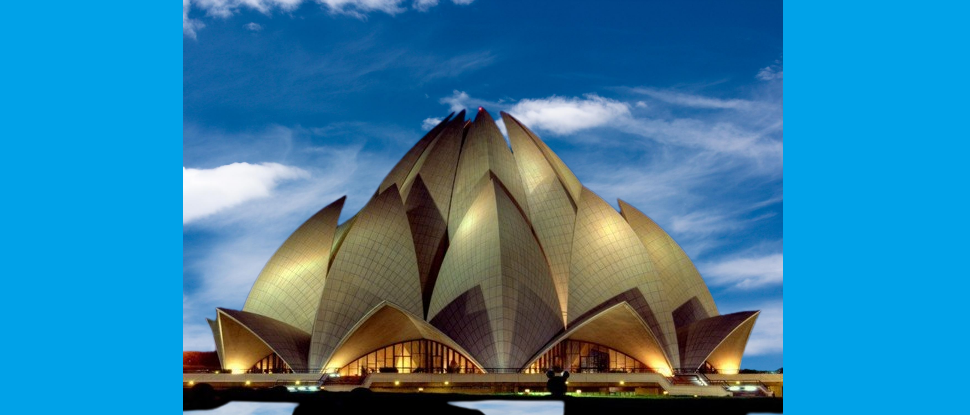T
he Lotus Temple, commonly known as the Baha Temple, is a famous example of Indian architecture in New Delhi. One of the most popular places of worship in the world. The main features of Lotus Temple are:
Beauty: Lotus Temple is famous for its unusual design inspired by flowers. Its design was completed in 1986 by Iranian-Canadian architect Fariborz Sahba.
The Lotus Temple is the most important Baha temple in India. The Bahá’í Faith attaches great importance to the equality of all people and the unity of all religions.
The lotus flower has an important significance in many religions and cultures. In Hinduism, Buddhism and Jainism, it represents purity, enlightenment and rebirth. It represents the purity and harmony of all beliefs in the Bahá’í Faith.
Open to all, the Lotus Temple welcomes people of all castes and religions. There is no religion or ritual inside. Instead it is a place of meditation, prayer and contemplation.
The water lily-like face is complemented by the Lotus Temple pattern, which consists of 27 marble “petals” arranged in groups of three to form nine arms. Its exterior is made of white marble sourced from Penteli, Greece.
Environment: The design of the Lotus Temple incorporates many environmentally beneficial elements such as lighting and ventilation. The church also collects rainwater for its water needs.
Awards and Recognition: Lotus Temple has won numerous architectural awards and accolades for its pioneering and ecologically responsible architecture. It is New Delhi’s most popular tourist attraction and the face of the city.
Peaceful Environment: The temple is surrounded by beautiful gardens, which maintains peace in the area.
Community Events: In addition to worship and meditation spaces, Lotus Temple hosts a number of community events to promote the Bahá’í Faith.
The Lotus Temple exemplifies the spiritual values of harmony, diversity and unity of the Bahá’í Faith. It is a masterpiece of architecture and spirituality that will inspire people from all walks of life.

What is Lotus Temple?
Lotus Temple or Bahai Temple New Delhi, this temple is also a place of meditation and worship, welcoming all religions and workers alike within its unique walls. The unique shape of the lotus, a flower of great importance in Christian and Hindu religions, was created by Iranian architect Fariborz Sahaba. The building was appreciated for its unique and beautiful design and aesthetic structure, which resembles a flower spread over a tranquil pond when viewed from the shore and from a bird’s eye view.

Who built the Lotus Temple?
The beautiful structure of the temple was designed by Iranian architect Fariborz Sahaba. He was invited to the project in 1976, before the land for the project was purchased. He was elected as President by the Bahá’í Governing Body because of his commitment to the Bahá’í Faith.
He worked in this journey for almost 10 years, not only as a designer but also as a project manager. It has been appreciated by artists around the world for its excellent performance.

Lotus Temple in New Delhi
Lotus Temple in New Delhi is a famous temple and tourist attraction in the city. Unlike other places of worship, where people often find statues of other deities to pray to, ask for forgiveness or meditate on, the Lotus Temple is an exclusive place of worship. It is famous for its beautiful flower-like architecture and wonderful weather, making it a popular tourist attraction for people of all religions. The Bahai Lotus Temple is one of the most beautiful in the world and is a must-see in Delhi.

History of Lotus Temple
There are many Bahá’í Houses of Worship around the world. These buildings are famous and popular for their magnificent architecture. The architect of Lotus Temple, Mr. Fariborz Sahba is deeply influenced by the distinctive architectural style of Indian temples and religious places. He took elements of the architectural style and built this beautiful house of worship in Delhi. The temple represents the three main aspects of the Bahá’í Faith: “the purity, simplicity and freshness of the Bahá’í Faith.”
The history of Lotus Temple dates back to 1953, when Shri Sahaba and his expert team laid the foundation of the temple. The main construction of the building began in 1980 and took six years to complete. In 1986, the Lotus Temple was opened to all who wished to visit and pray there.
The Bahá’í Faith believes in “the unity of faith, humanity and God”. According to the theory, all religions and people can be traced to one place; Although there are different teachings and beliefs in religions, in reality they are all “one” and come from the same Creator. Bahá’u’lláh, the founder of the Bahá’í Faith, declared that if the entire world were compared to countless and diverse human bodies, each body could play a special role in ensuring human survival.
The body works well. Similarly, every individual should cooperate with those around him or her and strive for a world where each individual can bring out his or her best. To use solar energy Lotus Temple is one of the first temples in Delhi. The total power consumption is 500 kW, of which 120 kW is provided by solar power. When you visit the Lotus Temple, you can visit the Information Center, which has extensive information about the Bahá’í Faith, including books, photos, videos, scriptures, and more. There is also a room and a library with religious books. It is reserved for tourists.
Nearest metro station lotus temple
The nearest metro station to the Lotus Temple in New Delhi is the Kalkaji Mandir Metro Station, which is located on the Violet Line of the Delhi Metro. From Kalkaji Mandir Metro Station, you can either walk or take a short auto-rickshaw ride to reach the Lotus Temple. It’s a convenient and efficient way to travel to the temple, especially considering Delhi’s traffic congestion.
Nearest bus stand lotus temple
The Lotus Temple in New Delhi is located near Nehru Place and Kalkaji, and there are several bus stands nearby from where you can reach the temple.
Nehru Place Terminal: This is a major bus terminal in the area, located near the Lotus Temple. You can catch buses from various parts of Delhi that stop here.
Kalkaji Bus Stand: Another option is the Kalkaji Bus Stand, which is close to the Lotus Temple. Buses from different parts of Delhi also stop here.
Greater Kailash Bus Stand: This bus stand is also relatively close to the Lotus Temple and serves as a stop for buses coming from different areas of Delhi.
From these bus stands, you can either walk or take a short auto-rickshaw ride to reach the Lotus Temple. Make sure to inquire about the routes and timings of the buses to plan your journey accordingly.